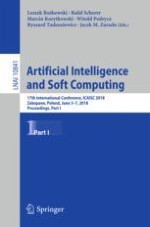2018 | Buch
Artificial Intelligence and Soft Computing
17th International Conference, ICAISC 2018, Zakopane, Poland, June 3-7, 2018, Proceedings, Part I
herausgegeben von: Prof. Leszek Rutkowski, Dr. Rafał Scherer, Marcin Korytkowski, Witold Pedrycz, Ryszard Tadeusiewicz, Jacek M. Zurada
Verlag: Springer International Publishing
Buchreihe : Lecture Notes in Computer Science
